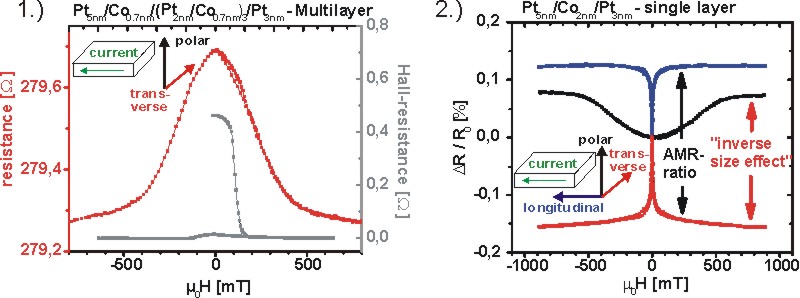In nonmagnetic materials the resistance changes and a Hall-voltage is induced when applying a magnetic field perpendicular to the current direction. These effects are consequences of the classical Lorentz-force, which acts on the charge carriers. In ferromagnetic materials this "ordinary" effects are also present but are superimposed by "anomalous" effects. These "anomalous" effects are quantum mechanic in nature (Spin-orbit coupling) and connect the electronic properties with the magnetization. Therefore, these effects can be utilized to reveal information about the magnetization behaviour. We use the anisotropic magnetoresistance (AMR) and the anomalous Hall-effect (AHE) to measure the magnetization behavior of submicron particles.
The AHE is proportional to the perpendicular component of magnetization and the AMR shows up, that the resistance depends on the angle between current and magnetization.

In figure 1.) the resistance and Hall-resistance of a Co/Pt multilayer with four repetitions are shown. This film exhibit an easy axis of magnetization perpendicular to the film plane caused by the interface anisotropy. Before the measurement the film is fully magnetized in polar direction (single domain state). Applying an in-plane field perpendicular to current (transverse geometry) the Hall-resistance drops rapidly at a field of about 100mT. That the net-magnetization vanishes means that domains are created. With increasing field the magnetization within the domains turn in field direction and a resistance decrease is observed until the magnetization is aligned parallel to field at about 500mT. Sweeping the field back to 0mT the Hall-resistance stays nearly at 0 Ohm. That means, that the net-magnetization in remanence is very small, thus the ratio of up- and down-domains is similar (multi domain state). On the contrary the resistance reaches the initial value. That means that the magnetic microstructure does not influence the resistance.
The variation in resistance with field can not be explained with the AMR, because the angle between magnetization and current does not change within the whole field range. At present, the reason for the difference between the polar and transverse resistance is investigated ("inverse size effect"). Figure 2.) shows the resistance of an in-plane magnetized single layer as a function of applied field for three field directions with respect to the current.
